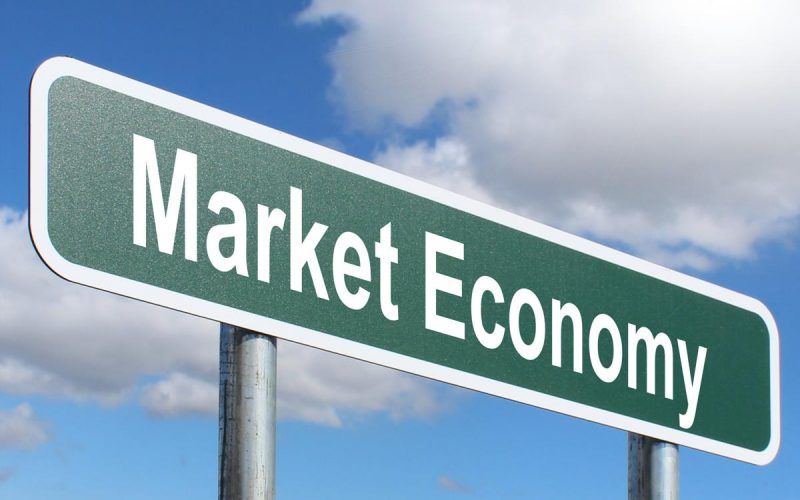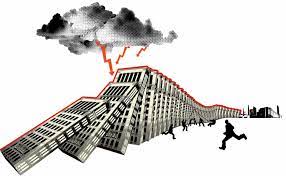Traditional, command, market, and hybrid economies are the four types of economies (a combination of a market economy and a planned economy). The modern economy is immensely complex, and the type of economic system that a nation employs determines its citizens’ economic lives. The market economy has been one of the most common economic systems throughout human history. Let us study more about the free market economy, its characteristics, and examples of benefits and drawbacks.
What is a Market Economy?
A market economy is described as a system in which the production of goods and services is determined by the changing desires and capacities of market participants. It enables the market to function freely in line with the law of supply and demand, which is set by individuals and corporations rather than governments.
The market economy principle states that producers and sellers of goods and services will provide them at the maximum price that consumers are prepared to pay for goods or services. A natural economic equilibrium is reached when the level of supply equals the level of demand.
A command economy, which is centralized and controlled by the government, is the polar opposite of a market economy.
Market Economy Characteristics
- Individuals are permitted to profit from private ownership of businesses and real estate. As under a command economy, ownership rights do not simply belong to the government.
- Market participants are free to manufacture, sell, and buy whatever they choose, subject to government laws.
- Individuals trying to sell their offerings to the highest bidder while paying the least for goods and services that they require drive the market (profit motive).
- Producers compete, which keeps pricing fair and assures efficient production and supply.
- Players have equal access to relevant information for making decisions.
- The government has a limited role in a market economy, but it serves as a regulator to promote fair play and prevent the formation of monopolies.
The United States, Canada, the United Kingdom, and Denmark are examples of countries with a market economy.
Understanding Market Economy
Classical economists such as Adam Smith, David Ricardo, and Jean-Baptiste Say provided the theoretical foundation for market economies. These classically liberal free market supporters felt that the “invisible hand” of the profit motive and market incentives often drove economic decisions in more productive and efficient directions than government economic planning. They felt that government action frequently resulted in economic inefficiencies that harmed people.
Theory of Market Economy
Market economies use supply and demand dynamics to establish the proper prices and quantities for the majority of commodities and services in the economy. Entrepreneurs gather production inputs (land, labor, and capital) and combine them with workers and financial backers to generate goods and services for consumers or other firms to purchase. Buyers and sellers willingly agree on the parameters of these transactions based on consumer preferences for specific commodities and the income that businesses expect to make on their investments.
Entrepreneurs allocate resources across different businesses and production processes based on the profits they aim to generate by generating output that their consumers value more than what the entrepreneurs spent for the inputs. Entrepreneurs who succeed are rewarded with revenues that can be reinvested in future ventures, while those who fail must either learn to improve through time or go out of business.
How a Market Economy Work
A market economy must have at least six traits in order to function.
#1. Ownership by Individuals
The majority of goods and services are privately owned. Owners can profit from their ownership by selling or leasing real estate, goods, or services.
#2. The Right to Choose
In a competitive market, owners are free to make, sell, and buy goods and services. They only have two variables that are somewhat beyond their control. To begin, a buyer must be willing to pay the price that the seller has set for their goods or services. Second, the amount of capital they own is governed by the costs of producing and selling their commodities, as well as the price at which they can sell them.
#3. Self-interest Motive
The majority of firms were founded with the interests of the persons who founded them in mind. A market economy creates opportunity, allows people to work for themselves, and allows them to care for their families in the best way possible.
One of the fundamental drivers of a successful market economy is self-interest. “We expect our dinner not from the goodwill of the butcher, brewer, or baker, but from their respect to their own profit,” wrote Adam Smith (1723–1790), a pioneer economist and philosopher.
Everyone offers their wares to the highest bidder while bargaining for the best deal on their purchases. Although the motivation is selfish, it is beneficial to the economy in the long run. It establishes an auction system in which prices for products and services are set to reflect their market value. In addition, the system generates an accurate picture of supply and demand at any given time.
#4. Competition
Prices remain low due to the weight of competitive pressure. It also ensures that society’s commodities and services are delivered more efficiently. Prices rise as demand for a particular item rises according to the law of demand.
Competitors recognize that by making the same thing and increasing supply, they may increase their profit. This drives down prices to the point where only the best competitors remain. This competitive pressure extends to both workers and consumers. Employees compete for the highest-paying jobs, while purchasers compete for the greatest goods at the best price.
#5. A Market and Pricing System
A market economy is dependent on an effective market for the sale of goods and services. When all buyers and sellers have equal access to the same information about prices, supply, and demand, a market is said to be efficient. As a result, price variations are only reflections of supply and demand rules. Demand is determined by five factors:
- Product cost
- Buyer’s earnings
- Prices of comparable goods
- Consumer preferences
- Buyer Preferences
There are six supply determinants:
- The market’s number of sellers
- The level of technology employed in manufacturing
- The amount of regulation, fees, or subsidies imposed
- The cost of other commodities
- Price expectations for the future
- The determinants of supply and demand are what drive the market system’s movements.
#6. Government should be limited.
One of the government’s responsibilities is to keep the markets open, functional, stable, fair, and safe. For example, the government establishes regulatory organizations to guarantee that items are safe for use and consumption and that firms are not exploiting consumers.
It also tries to ensure that everyone has equitable market access. Monopolies, or corporations that command a disproportionate share of the market, are punished by the government. Regulators seek to ensure that no one manipulates markets and that everyone has equal access to information.
Read Also: LIMITED GOVERNMENT: Definition, Examples, and How It Works
Advantages of a Market Economy
#1. Efficiency in Business
A market economy, as opposed to other types of economies, enhances corporate efficiency. The government’s ability to regulate transactions inside a market economy is limited, and the majority of the laws it enacts are designed to safeguard consumers, the environment, market players, and national security.
Governments’ limited role encourages increased efficiency and free and expanded competition. When there is competition, a firm will do all it takes to reduce expenses and increase sales in order to improve profits.
Because businesses compete with one another, they must devise strategies for gaining a competitive advantage and capturing a larger market share for their product or service. This prompts them to consider ways to cut expenses, improve their product, and so on in order to gain that extra market share.
#2. Increased Productivity
A market economy is also related to increased productivity. People require money to buy products and services in every economy. This desire increases incentive in a market economy because workers want to earn more money to supply their wants and live well.
The United States is thought to have a market economy, whereas China and Cuba are thought to have a socialist market economy.
When people are motivated to work, the economy benefits from greater production and output. There is less worker motivation in a command economy, when wages, production levels, prices, and investments are established by a central authority or government because no matter how hard you work, you will not experience any additional monetary advantage.
#3. Competitive Advantage Through Innovation
A country with a market economy has also raised its level of innovation. With money being the primary motivator for businesses and individuals, they seek to develop new products and technologies in order to increase their earnings. Firms and people in a market economy are encouraged to innovate in order to acquire a competitive advantage.
This differs from a command economy, in which the government controls all aspects of production, including supply and demand, and there is no motive for businesses to compete. Innovation also results in a greater range of goods and services, giving consumers more options.
Because businesses must figure out how to attract customers, competition usually results in higher quality items at reduced rates for consumers. This enables them to innovate not just in manufacturing but also in the quality of the products or services. Better technology results from innovation, which further improves society.
#4. Supply and demand are driven by consumers and business
Because a market economy allows for the free interaction of supply and demand, it ensures that the most desired goods and services are produced. Consumers are willing to pay the most for the items they desire the most. Businesses will only produce items that generate a profit.
#5. Profits reward for Innovations
innovative new products will better suit the wants of consumers than existing goods and services. These cutting-edge innovations will spread to other competitors, allowing them to become more profitable as well. This knowledge exchange exemplifies why Silicon Valley is America’s inventive advantage.
#6. Businesses invest in one another
The most successful companies invest in other top-tier businesses. This offers them an advantage and leads to higher manufacturing quality.
Related: Fortune 100 List of Companies in 2023 Updated!!!
Disadvantages of a Market Economy
The following are the downsides of a market economy:
#1. Competitive Disadvantages
A market economy is characterized by fierce competition, and there is no mechanism in place to assist individuals who are naturally disadvantaged, such as the elderly or persons with disabilities. Caretakers are also at a disadvantage because they must devote their time and resources to caregiving rather than working in the market.
#2. Inadequate optimization.
A market economy’s economic cost is that its members may not be optimum. Instead of becoming a doctor or scientist, an innately disadvantaged person may be forced to pursue a minimum-wage job to support their family.
#3. A significant social and economic divide exists.
Because market forces determine who wins and who loses in a market economy, there can be a huge disparity between the super-rich and the super-poor.
How Does the Constitution Protect the Market Economy in the United States?
The United States has the world’s most advanced market economy. The United States Constitution is one of the reasons for its success. It contains provisions that facilitate and safeguard the six features of a market economy. The following are the most important:
- Article I, Section 8, establishes a copyright clause to safeguard innovation as property.
- Article I, Sections 9 and 10, safeguard free enterprise and choice by forbidding states from taxing each other’s goods and services.
- By protecting citizens from arbitrary searches and seizures, Amendment IV preserves private property while also limiting government power.
- Amendment V safeguards private property ownership.
- The state is prohibited by Amendment XIV from taking away property without due process of law.
- Amendments IX and X limit the government’s ability to interfere with any rights that are not clearly stated in the Constitution.
The Preamble to the Constitution states a desire to ensure that the government supports everyone’s well-being. As a result, the government can play a bigger role than a market economy would. Social programs such as Social Security, food and nutrition services, foster care programs, and Medicare were created as a result of the government’s responsibility in ensuring more people are cared for.
Modern Market Economies
Every modern economy sits somewhere along a spectrum ranging from pure market to highly planned. Because they combine free markets with some government intervention, most industrialized countries have technically mixed economies. However, they are frequently referred to as having market economies since they enable market forces to drive the great bulk of activity, with government intervention being limited to providing stability.
Some government interventions, such as price-fixing, licensing, quotas, and industry subsidies, may still occur in market economies. Market economies are most typically characterized by government production of public goods, often as a government monopoly. Market economies, on the other hand, are characterized by decentralized economic decision-making by buyers and sellers conducting regular business. They are defined in particular by having functional markets for corporate control that allow for the transfer and rearrangement of economic means of production among entrepreneurs.
Although the market economy is clearly the most popular system, there is considerable disagreement on the level of government intervention that is deemed desirable for successful economic operations. Economists generally believe that more market-oriented economies will be more successful in terms of generating wealth, economic growth, and rising living standards, but they frequently disagree on the precise scope, scale, and specific roles for government intervention that are required to provide the fundamental legal and institutional framework that markets may require in order to function well.
Examples of countries with a Market Economy System
There are no totally free-market economies in the world today. Most economies are mixed market economies because they control some of the means of production. However, some economies are freer than others.
The five countries with the most economic freedom, according to the Fraser Institute’s Economic Freedom of the World Rankings, are Hong Kong, Singapore, New Zealand, Switzerland, and the United States. These research rates countries based on the following economic freedom pillars: personal choice rather than collective decision, voluntary exchange organized by markets, freedom to participate and compete in markets, and protection of people and property.
According to the Fraser Institute, the top 25 most economically free countries in the world are:
- HK
- Singapore
- Auckland, New Zealand
- Switzerland
- The United States
- Ireland
- The United Kingdom
- Canada
- Australia
- Mauritius
- Malta
- Georgia
- Chile
- Denmark
- Estonia
- Lithuania
- Japan
- Luxembourg
- Taiwan
- Germany
- Finland
- Czechoslovakia
- Iceland
- Latvia
- Netherlands
Examples of mixed socialist economies include Cuba, China, and North Korea.
Related: List of Fortune 1000 Companies in 2023
The Free Market Economy
Governments have a great level of influence over how wealth is produced and dispersed in both planned and command economies. They enact regulations governing the prices of products and services, establish employee compensation, and regulate how much any corporation or firm can own and produce.
In contrast, customer demand, rather than a central authority, drives how firms operate and the methods employed to manufacture goods and administer services in free-market economies. Commodities are sold at the highest feasible price, and individual organizations and businesses establish the pay and levels of supply for their employees. Profit is what drives all production, supply, and demand, forcing enterprises to be as efficient as possible, according to the notion of a free market economy.
What Attributes define a Free Market Economy?
A free-market economy is driven by private ownership and consumer supply and demand and is thought to be the closest economic system to ‘real’ capitalism. Many more features distinguish free-market economies from other types of systems, including:
- There will be no government meddling in the economy, including legislative authority over employment, output, or pricing. Instead, businesses and non-profit organizations such as the Chambers of Commerce are given complete legislative authority.
- Supply and demand drive production, resource utilization, and price setting.
- The private sector manufactures all commodities and services.
- Individuals or businesses own all of the properties.
- Buyers and sellers exchange any goods or services voluntarily, with sellers choosing any price they deem suitable.
- Individuals and financial entities have complete independence.
This total economic freedom is the system’s defining feature. It’s also one of the key reasons why there are so few truly free market examples around the economy.
What are the benefits of a free market economy?
So, who benefits from a free-market economy, and what advantages do individuals, businesses, and governments gain? Here are some of the primary benefits of a free-market economy:
- Consumers drive the products and services that thrive in free-market economies and contribute to determining their prices.
- Businesses must function efficiently and maintain their goods or services creative in order to compete effectively on the market. They also have more latitude to do so in a free market economy, with no government control or legislation.
- Entrepreneurship and innovative technology are rewarded because they help the economy better meet the requirements of customers.
- Profits are what drive profits. If a company is successful, other companies will invest in it, resulting in even more success and expansion.
What are some of the Drawbacks of a Free market economy?
Although free market economies provide numerous advantages for corporations, they also have certain drawbacks for smaller organizations and individuals:
In order to function, this economic system relies on competition within the private sector. This means that there is very little help for inefficient firms or vulnerable persons, such as the elderly, children, or those with impairments.
Individuals who are left to care for the most vulnerable cannot contribute fully in terms of economic or inventive contributions. For example, a young person who must care for a crippled brother must take a low-paying flexible job and cannot design the next great technological invention.
Success breeds success. Individuals and businesses that are successful in the free market economy are focused on driving their own profits rather than providing for others who are disadvantaged. There are many ethical considerations about who benefits from the free market economy, and caring for society’s most vulnerable must be a conscious decision in a free market economy.
Examples of a Free-market Economy
The United States is frequently regarded as the largest free-market economy example in the world. American democracy and society, which are based on the laws of capitalism and the forces of supply and demand, also promote entrepreneurial spirit and success. Consumer demand drives pricing and wealth distribution, with financial institutions wielding tremendous power in US society.
However, this is hardly the complete picture of the US economic system. Despite the fact that banks, corporations, individual consumers, and enterprises wield tremendous power in the US economy and society, the US Constitution allows the government to employ centralized control to boost the country’s growth, notably in defense and transportation. More recently, there has been increased government regulation over financial institutions, as well as financial support for individuals, to assist the US system in weathering economic downturns.
Because of this intervention, the United States is today considered a mixed economy, along with many of the world’s largest capitalist countries, particularly those in Europe. So, when it comes to the subject of ‘what is a free market economy,’ there are no other authentic examples in the global system. However, there are some communist-controlled command economies that are the polar opposite of the free market.
Other Types of Economic Models
Aside from a market economy, two more modern economic models exist:
#1. Command Economy:
A command economy is an economic system in which the government unilaterally selects which items should be produced, as well as their supply and cost, through central planning. A command economy can be found in North Korea, Cuba, and the former Soviet Union. For many years, China had a command economy before transitioning to a mixed economy.
#2. Mixed Economy:
Mixed economies incorporate aspects of both a capitalist market economy and a socialist-style command economy, allowing for some economic freedom but still allowing governments to intervene for certain social goals. The United States and the majority of Europe have mixed economies.
Although the United States permits corporations to determine their own prices and workers to negotiate their own pay, there is also government intervention in the form of antitrust laws and minimum wages. They also try to compensate for systemic disadvantages by instituting safety nets like social security and allocating government resources to public goods.
What is the role of technology in a market economy?
Technology’s role in today’s market economy cannot be overstated; it allows for more effective manufacturing, distribution, and final use of all goods and services. Lower prices, more rivalry, and higher living standards are all possible outcomes of this efficiency boost. Technology development may also result in the emergence of new economic sectors, which in turn may provide additional employment possibilities.
How does globalization impact a market economy?
The term “globalization” is used to describe the growing financial integration of national economies around the globe. Globalization in a market economy can increase competition, which in turn can reduce prices and increase supply. However, as businesses seek out countries with cheaper labor costs, globalization can lead to job losses.
What is the role of the stock market in a market economy?
The stock market is an important component of a market economy. It provides a platform for companies to raise capital by issuing stocks, which individuals can then buy and sell. The stock market also provides a way for people to invest their money and potentially earn a return. The stock market reflects the overall health of the economy, as the prices of stocks are influenced by the overall economic conditions and the performance of individual companies.
How does the market economy handle monopolies?
When one company controls the entire market for a product or service, it is called a monopoly. Monopolies in a market economy can cause price increases and less variety in products and services available to consumers. To combat this, governments may implement antitrust laws to regulate monopolies and stop corporations from abusing their position in the market.
What is the role of entrepreneurship in a market economy?
Entrepreneurship plays a crucial role in a market economy by creating new businesses and jobs. Entrepreneurs bring new products and services to the market, which can lead to increased competition and economic growth. Additionally, entrepreneurs also play an important role in generating new ideas and innovations, which can drive progress and improve living standards.
How does the market economy allocate resources?
In a market economy, resources are allocated through the interaction of supply and demand. If there is a high demand for a particular product or service, prices will rise, signaling to suppliers that they should produce more of it. On the other hand, if there is a low demand for a product or service, prices will fall, signaling to suppliers that they should reduce their production. This system of price signals ensures that resources are allocated to their most valuable uses.
Conclusion
A market economy is one in which resource allocation and the prices of products and services are determined by market variables, most notably the law of supply and demand. There is limited government intervention in market economies, enabling private ownership to make all company decisions based on market conditions. This economy promotes better efficiency, production, and innovation.
Market Economy FAQs
What's a pure market economy?
A pure market system entails the free trade of goods and services as well as private property ownership. This is the polar opposite of a full command economy, in which the government entirely controls the market and owns all property. Pure capitalism is another term for a pure market economic system.
Is there any true market economy?
A real free-market economy is one in which individuals own all resources. Individuals make decisions about how to allocate such resources, with no intervention from the government. There are no truly “free-enterprise” or market economies.
Is capitalism a free market economy?
A totally capitalist economy is also a free-market economy, which means that the law of supply and demand rules production, labor, and the marketplace rather than a central authority.






